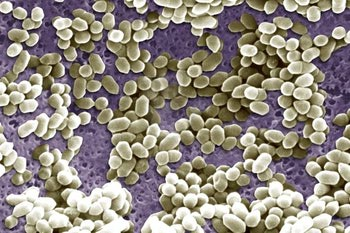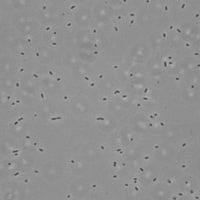Listeria ivanovii: Difference between revisions
No edit summary |
No edit summary |
||
| Line 32: | Line 32: | ||
[[Image:98787566754.jpg|200px|thumb|right|''Listeria ivanovii'' [http://pictures.life.ku.dk/atlas/microatlas/food/bacteria/Listeria_ivanovii/link1.htm]]] | [[Image:98787566754.jpg|200px|thumb|right|''Listeria ivanovii'' [http://pictures.life.ku.dk/atlas/microatlas/food/bacteria/Listeria_ivanovii/link1.htm]]] | ||
When grown close to ''Rhodococcus equi'' on blood agar, ''L. ivanovii'' give rise to a shovel-shaped patch of synergic haemolysis. This is used to differentiate ''L. ivanovii'' from ''L. monocytogenes''. ''L. monocytogenes'', which is the only other pathogenic species of ''Listeria'', is weakly haemolytic and does not produce a shovel-shape when grown next to ''R. equi'' (3). | |||
==Metabolism== | ==Metabolism== | ||
| Line 39: | Line 40: | ||
==Pathology== | ==Pathology== | ||
Upon becoming ingested by a ruminent, ''L. ivanovii'' develop a characteristic intracellular life cycle that includes six virulence factors. These steps include: early escape from the phagocytic vacuole, multiplication in the host cell cytoplasm, directional intracytosolic motility by induction of actin polymerization at one pole of the bacterial cell, protrusion of centrifugally moving bacteria within the cytoplasmic evaginations, and phagocytosis of the pseudopod-like structures by neighboring cells, in which the cycle reinitiates (1). Successful infection of ''L. ivanovii'' within a host can lead to septicaemic disease with enteritis, neonatal sepsis and abortion (5). | |||
Revision as of 00:31, 18 April 2012

Classification
Higher order taxa
Bacteria; Firmicutes; Bacilli; Bacillales; Listeriaceae
Species
Listeria ivanovii
Description and significance
L. ivanovii is a non-spore forming, gram-positive, rod shaped bacteria. L. ivanovii is pathogenic, mainly infecting small ruminants and cattle, causing septicemic diease. Human cases of disease caused by L. ivanovii are extremely rare (1).
Genome Structure
L. ivanovii contain one circular chromosome of 2,928,879 base pairs with 143 open reading frames and has an average G+C content of 37.1%. L. ivanovii contains six complete rRNA operons, 2,782 protein coding-genes, and 67 tRNA genes. The L. ivanovii genome contains 86 pseudogenes, of which 37 are truncated and 53 are interrupted by frameshift mutations (1).
Cell and Colony Structure

When grown close to Rhodococcus equi on blood agar, L. ivanovii give rise to a shovel-shaped patch of synergic haemolysis. This is used to differentiate L. ivanovii from L. monocytogenes. L. monocytogenes, which is the only other pathogenic species of Listeria, is weakly haemolytic and does not produce a shovel-shape when grown next to R. equi (3).
Metabolism
Ecology
Pathology
Upon becoming ingested by a ruminent, L. ivanovii develop a characteristic intracellular life cycle that includes six virulence factors. These steps include: early escape from the phagocytic vacuole, multiplication in the host cell cytoplasm, directional intracytosolic motility by induction of actin polymerization at one pole of the bacterial cell, protrusion of centrifugally moving bacteria within the cytoplasmic evaginations, and phagocytosis of the pseudopod-like structures by neighboring cells, in which the cycle reinitiates (1). Successful infection of L. ivanovii within a host can lead to septicaemic disease with enteritis, neonatal sepsis and abortion (5).
References
1. Vazquez-Boland, J., et al. 2001. Pathogenicity islands and virulence evolution in Listeria. Microbes and Infection, 3(7), 571-584.
2. Chakraborty, T., et al. 2000. Genome organization and the evolution of the virulence gene locus in Listeria species. Int. Journal of Medical Microbiology, 290, 167-174.
3. Gonzalez-Zorn, B. et al. 1999. The smcL gene of Listeria ivanovii encodes a shingomyelinase C that mediates bacterial escape from the phagocytic vacuole. Molecular Microbiology, 33(3), 510-523.
4. Buchrieser, C., et al. 2011. Complete Genome Sequence of the Animal Pathogen Listeria ivanovii, Which Provides Insights into Host Specificities and Evolution of the Genus Listeria.” Journal of Bacteriology, 193(23), 6787-6788.
5. Engelbrecht, F., et al. 1998. A novel PrfA-regulated chromosomal locus, which is specific for Listeria ivanovii, encodes two small, secreted internalins and contributes to virulence in mice. Molecular Microbiology, 30(2), 405-417.
Edited by Erica Ferrelli a student of Dr. Lisa R. Moore, University of Southern Maine, Department of Biological Sciences, http://www.usm.maine.edu/bio
